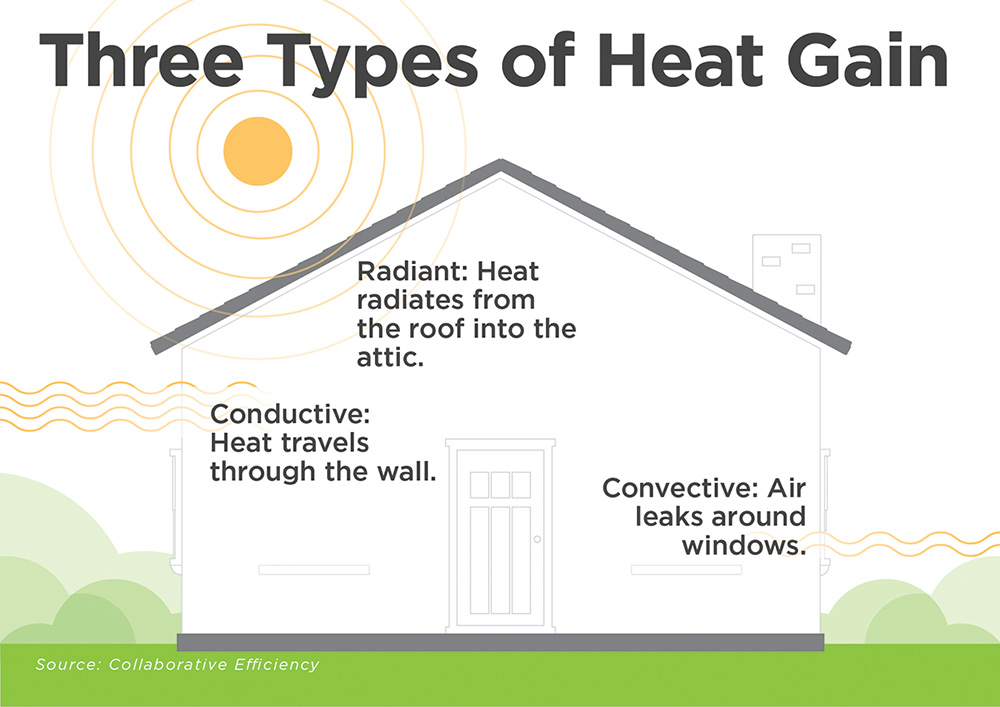By Pat Keegan and Brad Thiessen
Q: I’ve heard that installing a radiant barrier in my attic could save me a lot of money on my energy bill. What exactly is a radiant barrier, and does it really make a difference?
A: A radiant barrier reflects radiant heat and can be used to keep heat in a home during the winter and to keep heat out in the summer. To understand the value of a radiant barrier we need to consider the three different ways heat travels.
Convection is air movement from hot to cold. This happens through openings in your home, like doors, windows, vents and air leaks. 
Conduction is heat traveling through a solid material, such as the sheetrock and framing of your home. This can be minimized by insulation.
Radiant heat loss is a transfer of heat from the sun, or when a warmer material transmits infrared radiation to a colder material. Radiant barriers are designed to reflect this type of heat loss.
Radiant barriers often look like aluminum foil. Sometimes the foil is fastened to oriented strand board or foam board, but the foil will only reflect radiant heat towards an air space of at least one inch. If the foil is in contact with a solid material, it conducts excess heat into that material.
A common location for application of radiant barriers is the attic; radiant energy from the sun is sent back out of the roof before it can heat the air and insulation in your home. It is commonly sold as a roll of shiny, aluminum material and is usually mounted on the underside of the framing that supports the roof.
The radiant barrier is only effective in reflecting radiant heat, not as insulation or as a wrap to block air loss, but it can be very effective at its intended purpose. Even something as thin as a sheet of aluminum foil can reflect 95 percent of the radiated heat back through the roof if it’s installed properly, with an air gap between itself and the roof. While other solutions such as an attic fan try to remove the heat once it has accumulated, the radiant barrier stops the heat from building up in the first place.
foil can reflect 95 percent of the radiated heat back through the roof if it’s installed properly, with an air gap between itself and the roof. While other solutions such as an attic fan try to remove the heat once it has accumulated, the radiant barrier stops the heat from building up in the first place.
The net impact of a radiant barrier depends on whether you live in a hot or cold-weather climate. For example, homes that were retrofitted with attic radiant barrier systems in Florida were able to reduce air conditioning energy use by about 9 percent. In colder climates, the radiant barrier that reflects unwanted heat outside of the house in the summer will also be reflecting heat away from the house in the winter. In other words, the cooling bill may decrease but the heating bill may increase.
So, is a radiant barrier in your attic a good investment? Sometimes. You need to do a little research, as savings vary in each situation and there are many inaccurate claims made about the cost savings they bring. In a warmer climate, a home with a large cooling load and a roof that is fully exposed to the sun, an attic radiant barrier could be a cost-effective measure, and it could make your home more comfortable. Products are getting better all the time, but even then, your expectations need to be realistic.
It’s a good idea to compare an investment in an attic radiant barrier to other energy efficiency investments, such as improving your attic insulation or sealing air leaks around doors and windows. Of course, the best way to compare your energy efficiency opportunities is to schedule an energy audit of your home. Start by talking to your friendly energy advisors at your local electric cooperative.
This column was co-written by Pat Keegan and Brad Thiessen of Collaborative Efficiency. For more information on radiant barriers, please visit: www.collaborativeefficiency.com/energytips.
Patrick Keegan writes on consumer and cooperative affairs for the National Rural Electric Cooperative Association, the Arlington, Va.-based service arm of the nation’s 900-plus consumer-owned, not-for-profit electric cooperatives. Write to [email protected] for more information.




